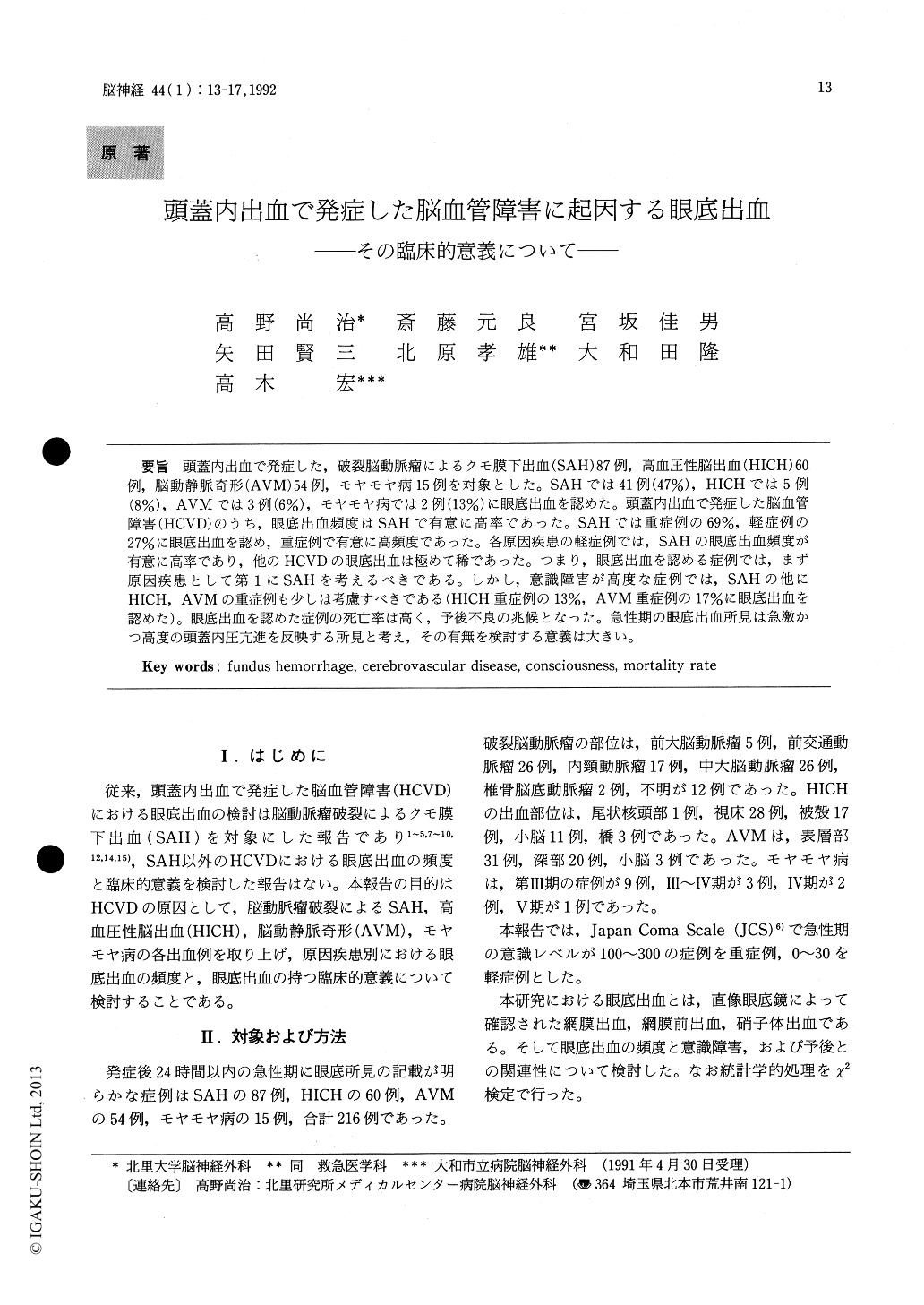Japanese
English
- 有料閲覧
- Abstract 文献概要
- 1ページ目 Look Inside
頭蓋内出血で発症した,破裂脳動脈瘤によるクモ膜下出血(SAH)87例,高血圧性脳出血(HICH)60例,脳動静脈奇形(AVM)54例,モヤモヤ病15例を対象とした。SAHでは41例(47%),HICHでは5例(8%),AVMでは3例(6%),モヤモヤ病では2例(13%)に眼底出血を認めた。頭蓋内出血で発症した脳血管障害(HCVD)のうち,眼底出血頻度はSAHで有意に高率であった。SAHでは重症例の69%,軽症例の27%に眼底出血を認め,重症例で有意に高頻度であった。各原因疾患の軽症例では,SAHの眼底出血頻度が有意に高率であり,他のHCVDの眼底出血は極めて稀であった。つまり,眼底出血を認める症例では,まず原因疾患として第1にSAHを考えるべきである。しかし,意識障害が高度な症例では,SAHの他にHICH,AVMの重症例も少しは考慮すべきである(HICH重症例の13%,AVM重症例の17%に眼底出血を認めた)。眼底出血を認めた症例の死亡率は高く,予後不良の兆候となった。急性期の眼底出血所見は急激かっ高度の頭蓋内圧亢進を反映する所見と考え,その有無を検討する意義は大きい。
To clarify the significance of fundus hemorrhage in the acute stage of intracranial hemorrhage due to cerebrovascular disease (HCVD), the incidence of such hemorrhage (retinal, preretinal, and sub-hyaloid hemorrhage) was examined and its correla-tions with the severity of the disturbance of con-sciousness and the prognosis were investigated. Two hundred sixteen HCVD patients with intra-cranial hemorrhage were the subjects of this study, including 87 cases of subarachnoid hemorrhage (SAH), 60 cases of hypertensive intracerebral hem-orrhage (HICH), 54 cases of arteriovenous malfor-mation (AVM), and 15 cases of Moyamoya disease. Fundus hemorrhage was recognized in 41 cases of SAH (47%) , 5 cases of HICH (8%), 3 cases of AVM (6%), and 2 cases of Moyamoya disease (13%).
The incidence of fundus hemorrhage was significantly higher in SAH than in the other type of HCVD associated with intracranial hemorrhage. Among patients with severe disturbance of con-sciousness (JCS 100-300), fundus hemorrhage was recognized in 69% with SAH, 13% with HICH, 17% with AVM, and none with Moyamoya disease. Therefore, patients with both fundus hemorrhage and severe disturbance of consciousness in the acute stage are most likely to have SAH, but HICH and AVM should be also taken into consideration. In patients with slight disturbance of consciousness (JCS 0-30), fundus hemorrhage was only noted in SAH (27%) and not in other types of HCVD as-sociated with intracranial hemorrhage. Thus, SAH is highly likely to be the primary HCVD associated with intracranial hemorrhage, if we recognize fun-dus hemorrhage in patients with slight disturbance of consciousness in the acute stage. Regardless of the type of primary HCVD causing intracranialhemorrhage, the mortality of the patients with fun-dus hemorrhage was quite high (90% in SAH, 100% in HICH, 100% in AVM, and 100% in Moyamoya disease).
It can be concluded that the fundus hemorrhage in the acute stage of HCVD causing intracranial he-morrhage reflects a sudden and critical increase ofintracranial pressure. This finding should be taken seriously, for it is strongly associated with severe disturbance of consciousness and a poor prognosis.

Copyright © 1992, Igaku-Shoin Ltd. All rights reserved.


